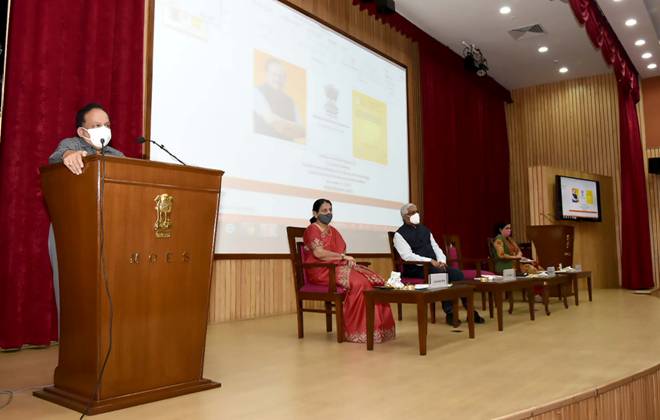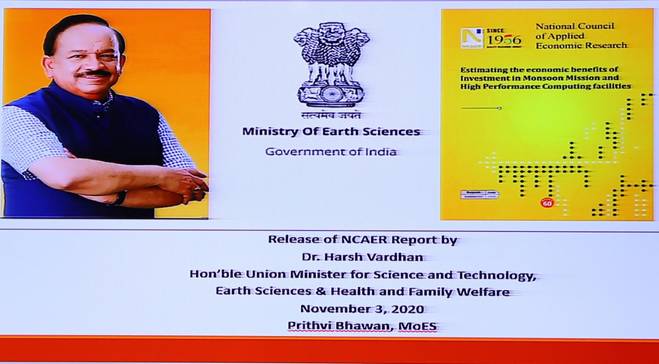Union Minister of Science and Technology, Health and Family Welfare and Earth Sciences, Dr. Harsh Vardhan today released the National Council of Applied Economic Research (NCAER) Report on “Estimating the economic benefits of Investment in Monsoon Mission and High Performance Computing (HPC) Facilities” at a function at Prithvi Bhavan in New Delhi.

Speaking on the occasion, the Minister said that the report has highlighted, “For every rupee spent by the government on the National Monsoon Mission and High-performance Computing programs of the Ministry of Earth Sciences(MoES), the country would gain economic benefits worth fifty rupees, which is 50 times more benefit on the investment over the next five years period”. NCAER is an independent, not for profit, economic policy research think tank based in New Delhi. The report is based on a study commissioned by M/o Earth Sciences, GoI.

Dr Harsh Vardhan said that “One of the most prominent weather services of IMD is the agro-meteorological services for farmers for their day to day operations. IMD in collaboration with Indian Council for Agricultural Research (ICAR) provides agro-meteorological advisories twice a week through around 400 district agro-met units for farmers in all districts”. “Recently, IMD started block level weather forecasts and warnings for farmers. At present farmers in 2000 blocks, are receiving advisories. As on today, these forecasts and warnings are disseminated to around 4.3 Crore farmers through various communication channels including Mobile App, Meghdoot and social media”, he added.
Stating that “Indian National Centre for Ocean Information Services (INCOIS) provides ocean state forecasts and warnings to fishermen going out to sea for fishing on daily basis”, Dr. Harsh Vardhan pointed out, “These forecasts and warnings are also disseminated to fishermen through all communication channels. At present around 7 lakh fishermen receive ocean state forecasts and warnings”.
The Minister said that Government of India has launched the Monsoon Mission in 2012 with an objective to improve weather and climate forecasts over the country in all time scales, and highlighted that through the monsoon mission, MoES could establish the state of the art dynamical models for weather and climate forecasts. He also said “To augment the computing resources, MoES also augmented the HPC facility at Indian Institute of Tropical Meteorology (IITM), Pune and National Centre for Medium Range Weather Forecasting (NCMRWF). The earlier capability of about 1.2 petaflops was upgraded to around 10.0 petaflop HPC facility. The present facility is the best HPC facility in the country and the fourth best among the weather prediction centres around the world, after US, UK and Japan”.
Secretary, M/o Earth Sciences, Dr. M. Rajeevan, in his address said that MoES has also developed capabilities for measuring and forecasting air-pollution in Delhi as well as various application tools in diverse sectors including in Agriculture and Energy. He highlighted that the accurate and timely forecasts by the MoES/IMD on natural disasters like cyclones, flooding etc, have benefitted disaster management in minimizing their impact, thereby saving lives and property. He said that the Ministry is in the process of developing capabilities of assessing and forecasting in sectors like Energy & Power, Water resources and Health. The Ministry is also expanding its flood warning system to benefit more cities/states in the country, he added.
Dr. M. Mohapatra, DG, IMD; Dr.Parvinder Maini, Project Director and Scientist ‘G’ and several senior officials of MoES and IMD were present on the occasion while all institutions under MoES joined via the virtual platform.
SALIENT ASPECTS of the report-.
• A total of Rs. 1000 crores has been invested in setting up National Monsoon Mission(NMM) and High performance Computing (HPC) facilities by Government of India.
• Objectives of the report: To estimate the economic benefits of the investments made in NMM and HPC, through the income gain to the farmers in rain-fed areas, livestock owners and fishermen by adopting the weather and ocean state forecast respectively. The report also examined the economic benefits with gender perspective
• 173 districts spread across 16 states of India, were selected for the survey (rain-fed)
• A face-to-face survey of 6,098 respondents (including 3,965 farmers, 757 marine fishermen and 1,376 livestock owners) was conducted to gauge the economic impact and an Interactive Voice Response Survey (IVRS) of around 2 lakh respondents was conducted to validate the findings of face-to-face survey.
• 98% farmers made modifications to at least one of the nine critical practices* based on the weather advisories such as changed variety/breed; arranged for storage of harvest; early/delayed harvesting; changed crop; early/delayed sowing; changed schedule of ploughing/land preparation; changed pesticide application schedule; changed fertilizer application schedule; and changed scheduled irrigation. 94 % of these could either avoid loss or saw an increase in income.
• 76% of the livestock owners are using weather information for taking decisions on modification of shed/shelter; vaccination against seasonal disease; and fodder management.
• 82% of fishermen reported using Ocean State Forecast (OSF) advisories every time before venturing into sea.
• 95% of them reported to have avoided empty trips by following OSF advisories, which helped them save Rs. 18.25 crores of operational cost by avoiding venturing into the sea.
• Potential Fishing Zone (PFZ) advisories resulted in successful trips generating additional fish catch. A total of about Rs. 1.92 Crore additional income was generated from the 1,079 successful fishing expeditions made using PFZ Advisories.
• The total annual economic benefits to the 1.07 Crore Below Poverty Line (BPL) agricultural households (farmers and livestock owners taken together) works out to be Rs. 13,331 Crores and incremental benefit over the next five years is estimated to be about Rs. 48,056 Crores for the farming community.
• Annual income gained by 53 Lakh BPL fisher households is estimated to be Rs. 663 Crores and the present value of benefits accruing to fisher-folk works out to be Rs. 2,391 Crores over a period of 5 years.
• Hence, a total of Rs. 50,447 Crores is the present value of economic benefit accruing to agricultural households and fisherfolk, realised over the 5-year period.
• With an initial investment of Rs. 1,000 Crores, NMM and HPC facilities result in a 50-fold increase in its economic benefits.
• Derived estimated benefits realized by the women works out to be Rs. 13,447 Crores, which is 26.6 percent of the total benefit.

Click here for the full report.
Click here for the PPT presentation.
[The full report is also available at the website of Ministry of Earth Sciences (http://www.moes.gov.in).]
*****
NB/KGS/(MoES inputs)



